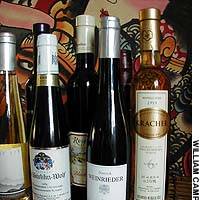Like many of us, William's love of the grape began with a sip of a sweet wine, in his case a thimble-full of late-harvest Gewurtztraminer offered by his mother to a curious 12-year-old. Even all these years later, he still claims to remember that sense of sticking one's head into an armful of lilies, stunned that such a small glass could pack such a large wallop.
It is no surprise that many wine drinkers are first attracted to dessert wines, as they offer comforting sweetness together with intriguing floral notes for the whites, and interesting chocolate tones for the reds.
The next step for many people is to move from dessert wines to slightly drier but still wonderfully perfumed dry whites, such as Gewurtztraminer and Riesling, and then into a classic Chardonnay phase. From there, many jump to red wine, some with such a fervor that they eschew white wines altogether for many years, or even decades.
A familiar story to many, but whether people claim to ultimately be "red" drinkers or "white" drinkers, most unfortunately retain a skepticism about any sweetness in a wine, perhaps because it reminds them of their own neophyte days.
And yet some of the most unique and sought-after wines in the world are sweet. As the years go by, we're more inclined to say forget the cakes and chocolate -- true contentment lies in sipping a luscious dessert wine at the end of a meal.
While the last few hundred years have seen the introduction of artificially fortified wines such as sherry and port, naturally occurring dessert wines have been made since at least the eighth century B.C.
In Hesiod's classic treatise on agriculture in Ancient Greece, "Works and Days," he describes how grapes should be dried in the sun for 10 days, and then in the shade for a further five before fermenting the wine in jars.
Although the technique has been refined a bit over the ensuing three millennia, an antiquarian vintner would be at home at many European dessert winemaking operations today.
In both France and Italy, winemakers choose special bunches of ripe grapes that are in perfect condition (loose clusters for good air circulation, and no broken skins or mold), and place them on straw mats in their winery's attic. After drying for a period of two to four months, these raisined grapes are pressed, sometimes for as long as three days. The tiny amount of extracted juice is made into wine called vin de paille in France (literally "straw wine" and certainly not to be confused with the rough country vin de pays wine designation). In Italy, such dried grape wine is called vin santo, or "holy wine."
The main effect of such an extended period of drying is the loss of water in the grapes (between 10 percent and 60 percent of the water is lost, depending on the drying time), and the ensuing concentration of sugars. Meanwhile, there are a number of microbiological transformations happening that are different from those that occur during fermentation. The effect is a rich, caramelized and, yes, almost strawlike taste that in the best examples can often last a minute or more.
A less labor intensive, and hence more affordable, technique is to simply leave the grapes on the vine well beyond the point at which they first reach ripeness. Although this risks destruction by rain, rot or hungry animals, a few extra weeks' "hang time" in the late fall can produce wines of wonderful concentration.
Such "late-harvest" wines are among our favorite affordable late-night tipples, with the best examples coming from California and Australia. Though usually made from the classic white varietals Semillion and Sauvignon Blanc, it is also possible to find a number of delicious late-harvest Zinfandels, good for those who occasionally like to sip a chocolaty, almost port-like red wine.
The king of all dessert wines, however, has its origin in one of the least expected places: rot.
Although mold and rot are normally the bane of all farmers, a common vineyard mold known as Botrytis cinerea is capable of dehydrating grapes without destroying them -- but only if conditions are perfect. The meeting point of the Ciron and Garonne rivers in the Sauternes district of France, and the marshlands of Austria's Burgundland district, are both blessed with a rare combination of repeating cycles of morning fog and hot, dry afternoons in the late autumn.
The humid mornings are conducive to the spread of botrytis mold throughout the vineyard, but the dry afternoons keep it from growing out of control (in less optimal conditions, a "gray rot" manifestation of botrytis can destroy the entire crop in a matter of days). After a few weeks of being covered in this "noble rot" the grape clusters look absolutely disgusting, but the little juice that remains inside each berry has undergone an incredibly complex transformation.
Workers pass through the vineyard as many as six different times, handpicking only those grapes that have the right degree of mold. Production is minuscule and labor costs are extraordinary, but the resulting "botrytized" wines (Sauternes in France, Trockenbeerenauslese in Austria), exhibit a combination of honey, citrus and spice that is unique in the world.
Cave de Relax (1-6-11 Nishi Shimbashi, [03] 3595-3697) has a small but well-chosen list of dessert wines in half-bottles, as do many other Tokyo fine-wine retailers. Most restaurants have a dessert white and a dessert red available by glass, a good way to try a number of different styles before buying a bottle, or case, for home.
For this Valentine's Day, by all means think sweet, but don't forget to also think wine!

















With your current subscription plan you can comment on stories. However, before writing your first comment, please create a display name in the Profile section of your subscriber account page.